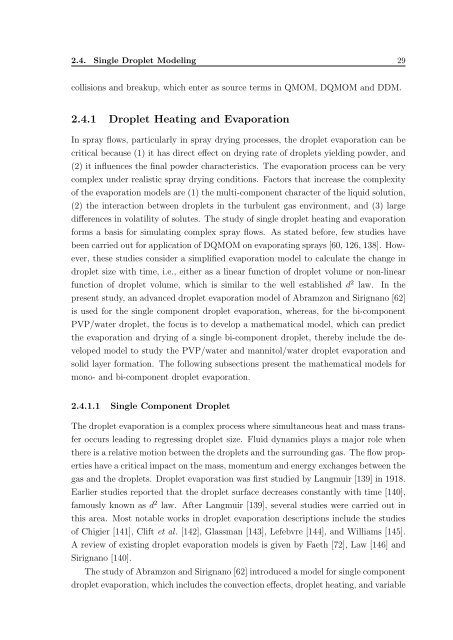INAUGURAL–DISSERTATION zur Erlangung der Doktorwürde der ...
INAUGURAL–DISSERTATION zur Erlangung der Doktorwürde der ...
INAUGURAL–DISSERTATION zur Erlangung der Doktorwürde der ...
You also want an ePaper? Increase the reach of your titles
YUMPU automatically turns print PDFs into web optimized ePapers that Google loves.
2.4. Single Droplet Modeling 29<br />
collisions and breakup, which enter as source terms in QMOM, DQMOM and DDM.<br />
2.4.1 Droplet Heating and Evaporation<br />
In spray flows, particularly in spray drying processes, the droplet evaporation can be<br />
critical because (1) it has direct effect on drying rate of droplets yielding pow<strong>der</strong>, and<br />
(2) it influences the final pow<strong>der</strong> characteristics. The evaporation process can be very<br />
complex un<strong>der</strong> realistic spray drying conditions. Factors that increase the complexity<br />
of the evaporation models are (1) the multi-component character of the liquid solution,<br />
(2) the interaction between droplets in the turbulent gas environment, and (3) large<br />
differences in volatility of solutes. The study of single droplet heating and evaporation<br />
forms a basis for simulating complex spray flows. As stated before, few studies have<br />
been carried out for application of DQMOM on evaporating sprays [60, 126, 138]. However,<br />
these studies consi<strong>der</strong> a simplified evaporation model to calculate the change in<br />
droplet size with time, i.e., either as a linear function of droplet volume or non-linear<br />
function of droplet volume, which is similar to the well established d 2 law. In the<br />
present study, an advanced droplet evaporation model of Abramzon and Sirignano [62]<br />
is used for the single component droplet evaporation, whereas, for the bi-component<br />
PVP/water droplet, the focus is to develop a mathematical model, which can predict<br />
the evaporation and drying of a single bi-component droplet, thereby include the developed<br />
model to study the PVP/water and mannitol/water droplet evaporation and<br />
solid layer formation. The following subsections present the mathematical models for<br />
mono- and bi-component droplet evaporation.<br />
2.4.1.1 Single Component Droplet<br />
The droplet evaporation is a complex process where simultaneous heat and mass transfer<br />
occurs leading to regressing droplet size. Fluid dynamics plays a major role when<br />
there is a relative motion between the droplets and the surrounding gas. The flow properties<br />
have a critical impact on the mass, momentum and energy exchanges between the<br />
gas and the droplets. Droplet evaporation was first studied by Langmuir [139] in 1918.<br />
Earlier studies reported that the droplet surface decreases constantly with time [140],<br />
famously known as d 2 law. After Langmuir [139], several studies were carried out in<br />
this area. Most notable works in droplet evaporation descriptions include the studies<br />
of Chigier [141], Clift et al. [142], Glassman [143], Lefebvre [144], and Williams [145].<br />
A review of existing droplet evaporation models is given by Faeth [72], Law [146] and<br />
Sirignano [140].<br />
The study of Abramzon and Sirignano [62] introduced a model for single component<br />
droplet evaporation, which includes the convection effects, droplet heating, and variable













